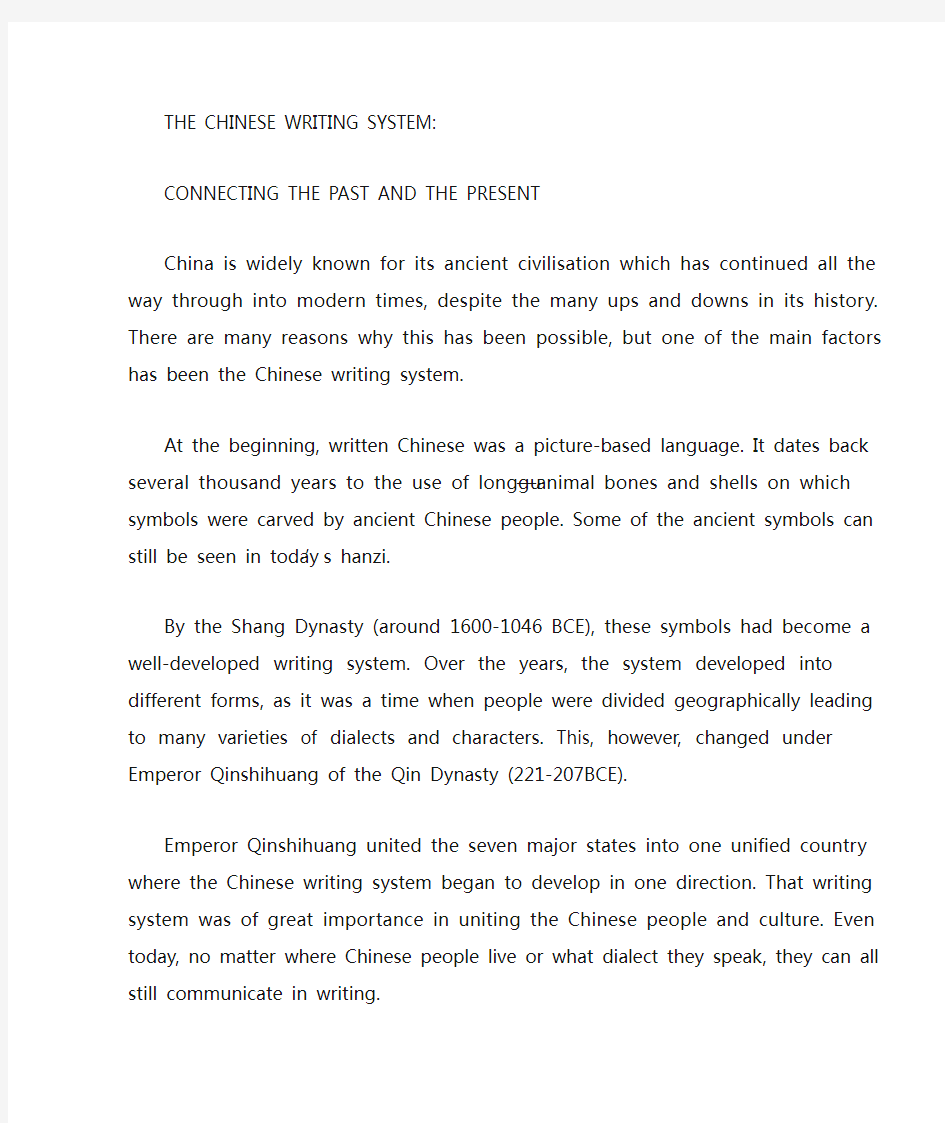新人教版必修一unit5 reading and thinking 课文中英对照


THE CHINESE WRITING SYSTEM:
CONNECTING THE PAST AND THE PRESENT
China is widely known for its ancient civilisation which has continued all the way through into modern times, despite the many ups and downs in its history. There are many reasons why this has been possible, but one of the main factors has been the Chinese writing system.
At the beginning, written Chinese was a picture-based language. It dates back several thousand years to the use of longgu—animal bones and shells on which symbols were carved by ancient Chinese people. Some of the ancient symbols can still be seen in today’s hanzi.
By the Shang Dynasty (around 1600-1046 BCE), these symbols had become a well-developed writing system. Over the years, the system developed into different forms, as it was a time when people were divided geographically leading to many varieties of dialects and characters. This, however, changed under Emperor Qinshihuang of the Qin Dynasty (221-207BCE).
Emperor Qinshihuang united the seven major states into one unified country where the Chinese writing system began to develop in one direction. That writing system was of great importance in uniting the Chinese people and culture. Even today, no matter where Chinese people live or what dialect they speak, they can all still communicate in writing.
Written Chinese has also become an important means by which China’s present is connected with its past. People in modem times can read the classic works which were written by Chinese in ancient times. The high regard for the Chinese writing system can be seen in the development of Chinese characters as an art form, known as Chinese calligraphy, which has become an important part of Chinese culture.
Today, the Chinese writing system is still an important part of Chinese culture. As China plays a greater role in global affairs, an increasing number of international students are beginning to appreciate China’s culture and history through this amazing language.
汉语书写体系:连接古今
尽管历史跌宕起伏,中国因其古老文明一直延续至今而闻名于世。其存续的原因有很多,但主要因素之一是汉字的书写体系。
起初,汉语是一种基于图形的语言。它可以追溯到数千年前使用龙骨的时期——古代中国人在这些骨头和壳上面刻画简单的符号。这些符号在今天的汉字中仍然可以看到。
到商朝(约公元前1600年~前1046年右)时,这些符号已经演变成一套完善的书写体系。在随后的年代里,这一体系发展成了不同的形式,这是由于当时中国人居住地域的分隔,从而导致不同的方言和汉字变体的产生。然而,这在秦朝(公元前221-前207年)秦始皇统治时期发生了变化。
秦始皇统一七个诸侯国后,在这个统一的国家里,汉字书写体系开始朝着一个方向发展。这一书写体系对于团结中国人民和中国文化具有重要意义。即使在今天,不管住在哪里,也不
管说何种方言,中国人都仍能通过书写(文字)进行交流。
汉语也成为连接中国现在与过去的一个重要媒介。现代中国人可以阅读古代中国人撰写的经典作品。中国人对其书写体系推崇备至,这体现在汉字发展为一种艺术形式——书法。书法已经成为中国文化的重要组成部分。
如今,汉字书写体系仍然是中国文化的重要组成部分。随着中国在全球事务中扮演着越来越重要的角色,越来越多的国际学生开始通过汉字这一奇妙的语言了解和欣赏中国的文化和历史。
